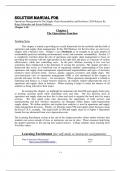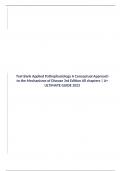Solution Manual For
Operations Management In The Supply Chain Sustainability and Resilience 2024 Release By
Roger Schroeder and Susan Goldstein
Chapter 1-18
Chapter 1
The Operations Function
Teaching Notes
This chapter is aimed at providing an overall framework for the textbook and the field of
operations and supply chain management. In this 2024 Release, for the first time, we start every
chapter with a business story. Chapter 1 uses Starbucks as an example of an early adopter of
sustainability practices including environmental, social, and economic sustainability. Section 1.2
is completely rewritten about the role of operations and supply chain management to focus on
providing the customer with the right product at the right time and place as a measure of system
effectiveness, while also controlling costs. In the past, offshore sourcing at low cost has
sometimes been emphasized to the detriment of serving the customer. The chapter provides a
framework that serves as a beneficial way of organizing students' understanding of five major
operations and supply chain management organizational responsibilities and types of decisions
needed to meet customer needs: process, quality, capacity, inventory, and supply chain. The
cross-functional view of operations management (OM) is also introduced in this chapter to
provide relevance for the course -- for non-majors. When operations management is related to
marketing and finance as a major business function, all students readily understand the role of
operations and supply chain in business. When teaching it helps to retain the interest of all
students as being relevant to their major.
In teaching this chapter, we highlight the important role that OM and supply chains play
in meeting customer needs while controlling costs and risks. The five decision areas in
operations and supply chain are how this is done and used to organize the book into five major
sections. We also spend some time discussing the importance of both services and
manufacturing and how business operations are managed within larger, multi-organization
supply chains. We define analytics and explain how analytics is used in operations and supply
chain management decisions. Finally, we illustrate major OM and supply chain decisions using
the Pizza U.S.A. example. The typical jobs in OM and supply chain in a Chapter 1 Operations
Leader box are abstracted from www.ziprecruiter.com.
The Learning Enrichment section at the end of the chapter provides videos and/or websites that
students can access outside of class or instructors can use in class. These resources help bring
the chapter materials to life and tap into student interest. College students enjoy learning from
YouTube videos.
Learning Enrichment (for self-study or instructor assignments)
What is Operations Management Video
https://youtu.be/leMOReAE2hk 5:19
1-1
, Supply Chain Management: A Force for Good. Video
https://youtu.be/Bl0UhiOvrdc 5:01
Coca Cola: Supply Chain Video
https://youtu.be/UBSOiHUctrY 2:29
Sustainability Web Link
https://www.epa.gov/sustainability/learn-about-sustainability#what
Globalization Web Link
https://world101.cfr.org/global-era-issues/globalization/what-globalization
Answers to Questions
1. Operations and supply chain management is ubiquitous, that is present in every
organization. Daily, we consume various goods and services produced by the
transformation of inputs to outputs under the control of operations managers. Operations
and supply chain management is a core business function along with marketing and
finance. All decisions are aimed at meeting customer needs, while controlling costs, and
are cross-functional in nature. You will be interacting with the operations function no
matter what career you choose. Much of what is learned related to operations and supply
chain management can be applied to other functions.
2. Operations management is a broader term than production management, encompassing
service organizations as well as manufacturing. Operations management is also a more
recent term replacing the earlier term production management.
3. The difference between operations and supply chain management is operations
management focuses on decisions to manage the transformation process that converts
inputs into desired finished goods or services within a single firm. Operations
management occurs within and across multiple facilities in an organization. Supply chain
management relates to the network of manufacturing and service operations that supply
each other from raw materials through manufacturing to the ultimate customer. The
supply chain consists of the flows of materials, money, and information along the entire
chain of sourcing, production, and distribution. The supply chain links the operations of
many different organizations to satisfy customer needs.
4. Responsibilities differ among operations, marketing and finance managers. A marketing
manager identifies demand for goods or services and develops the market, whereas the
operations manager assures supply of the products or services. The finance manager
acquires and allocates the capital resources for the other functions. Similarities in the
three functions include managerial decision making and shared organizational goals.
5. Operations, marketing, and finance are primary functions of the organization. Human
resources, information systems, and accounting are supporting functions that provide
resources and services for the three primary functions. The operations manager applies
resources, analysis and information provided by supporting functions and integrates them
1-2
, into decision making. The focus of the operations manager is on decision making rather
than on analytic methods.
6. a. The purpose of a college library is to make information available to students and
faculty for research and studying. The output is the bundle of services provided
along with facilitating goods: buildings, computers, books, catalogs and indices.
Process -- facility layout considering book stacks, reference rooms, computer
access on-site and from off-site, degree of computer use and procedures for
accessing and circulating information. They must not only select the appropriate
process, but manage the flow of users and information.
Quality -- standards of the college library profession are adopted; quality
measures include: ratio of consulting staff hours to students, rate of new book
and other material purchases, number of complaints, student satisfaction.
Capacity -- forecasting of library user needs contributes to decisions on building
size, volume of space for study and materials, print acquisitions, computer work
stations, staff hiring and scheduling of shifts.
Inventory -- decisions concerning the number of books, periodicals, etc. to stock.
Supply Chain – decisions about sourcing of materials and information. Also,
decisions are made about best to distribute printed and online materials, along
with moving materials and information into the library.
b. The purpose of a hotel is to attract and satisfy conventioneers and overnight
guests. The output is the bundle of services and goods provided: overnight
accommodations, maid service, room service, television, pool, bar, coffee shop.
Process -- a set of processes for reserving and payment of rooms, housekeeping,
restaurant, recreation services, and ongoing study of service methods; the people
who implement these processes including receptionists, accountants,
housekeepers, and maintenance workers.
Quality -- hotel industry standards and the market positioning of the hotel (first
class vs. budget) determine standards; quality measures include number of return
visitors, conventions booked, and ratings by industry evaluators.
Capacity -- number of units and beds; appropriate size for restaurant, bar and
convention halls; staffing for housekeeping, restaurant and office. Scheduling of
the workforce is also included.
Inventory -- goods to meet requirements for room upkeep (towels, sheets, etc.),
convention catering (glasses, dishes, food), restaurant and bar.
1-3
, Supply chain – decisions about sourcing the various materials and services used
by the hotel. Logistics is about moving materials and services to the hotel and
then return and recycling of goods.
c. The purpose of a small manufacturing firm is to provide customers with a quality
product at a reasonable price. The output consists of not only the physical good
but also any services that accompany the good, such as assistance in selecting the
good (the shopping process) or a warranty.
Process -- the process of securing the raw materials, transforming and assembling
them into a finished good, packaging the product, and arranging for its delivery to
customers.
Quality -- definition of quality standards for the manufactured goods,
measurement of deviations from design standards, inspection and control of
quality of input materials, prevention of defects.
Capacity -- number of units the facility is capable of producing per unit time, size
of inventory storage, hiring of workers and scheduling of shifts.
Inventory -- raw material inputs, work-in-process, and finished goods, used to
smooth production and meet customer needs.
Supply chain – Sourcing of materials and services used in the manufacturing
process. The distribution and storage to and from the manufacturing plant.
7. a. Operation -- college library
Inputs -- librarians, staff, library facilities and equipment, energy, capital.
Transformation process -- organizing information, arranging materials for access,
interacting with library users.
Outputs -- students and faculty provided with research and study materials.
b. Operation -- hotel
Inputs -- facilities, staff, materials for housekeeping and food preparation,
communications equipment, energy, capital.
Transformation process -- taking reservations, check-in and check-out procedures,
providing a comfortable experience, cleaning rooms, and providing other services.
Outputs -- customers satisfied with lodging and related services.
c. Operation -- small manufacturing firm
Inputs -- raw material, workers, supervisors, management, warehouse,
manufacturing facilities and equipment, energy, capital.
1-4





